1.
Pātaka.
A storehouse. There are two types of pātaka:-
a. Pātaka kai, for storing food, a utilitarian pantry that rats, mice and
cockroaches can't get into. Here is a pākata in Ohinemuta
in the 1850s.
for storing food, a utilitarian pantry that rats, mice and
cockroaches can't get into. Here is a pākata in Ohinemuta
in the 1850s.
I spent my WW2 preschool years with my mum and
grand-parents in the old Mangamahu hotel, built in the
days of clay tracks, when several months supply of wheat,
sugar, oatmeal and chook food was stored for winter in a
rat-proof little house on stilts and called what I thought
was the Pa Tucker, like the jolly swagman's tucker-bag. My
Grandad's Maori vocab was quite different from that of
today's Pakeha. No talk of iwi, mahi, or Fanga-ehu. He
talked of getting his pikau and pōtae before repairing the
'puckerooed' konaki he needed to haul some pungas from
near the W'ong'ehu river.
b. Pātaka whakairinga korero, a storehouse for
hanging stories. This referred to the stories in the
patterns carved in rafters and woven into wall panels of a
wharepuni, but metaphorically it can be a geographic
feature so-named to remind us of something historical,
like the Whanganui estuary that reminded the Polynesian
settlers of Fa'anui harbour back in Rangiatea. It could
also be used to describe archived documents like Apirana
Ngata's four volumes of moteatea, or a teller of
traditional stories like "old Aunty Queenie down at
the marae." Or this website!
Were there also Pataka taonga for the
safekeeping of greenstone carvings, ariki's cloaks
etc?
This waiata refers to some of the stories stored on
the mountain:
it
is a topknot giving status,
it
nourishes the island with minerals,
it
supports the heart of the people,
it
produces milky waters like whale's milk,
it
is a sleeping giant
it
provides healing waters
it is a
boundary marker
2.
Paretaitetonga
The "protective topknot of the southern
seas," is now just the topo-graphical name of Ruapehu's
most eastern peak, but it is a far more poetic name for
our mountain than "Exploding Hole."
Pare, koukou and tikitiki can all be used to describe a
topknot.
The root meaning of pare is "ward off, protect". The
lintel above the door of a wharepuni is also called a pare
because those who pass under it are moving into the domain
of Rongo, the god of peaceful activities.
The root meaning of kou is "a knob" => so koukou is a
knobby topknot, i.e. it is a bun.
The root meaning of tikitiki is "going back and forth"
=> plaiting => so a tikitiki topknot would be
plaited. Thus Maui Tikitiki's mother plaited her hair
around him after his premature birth.
Topknots were a favourite among high
ranking-Maori. Every person's head is tapu, and a person
of higher status showed it by his specially dressed hair,
with huia feathers, combs and oils being used to create
various hairstyles.
Thus Ruapehu, decorated with its huia feather of rising
smoke, displays the mana of the mountain, as well as the
mana of the iwi who live beneath it and who protect the
mountain's mana in return.
The Polynesian settlers who settled around Ruapehu were
excellent agriculturalists, and they recognized that the
periodic deposits of ash from the "topknot" provided the
minerals and soil texture helping to maintain the fertility
of the land. Even today, the root vegetables grown beneath
the mountain give this region a special status.
Paretaitetonga is first mentioned in print in the
New
Zealander, May 1851, as a poetic refuge for the
survivors of the 1822 Matakitaki massacre.
3. Pou-toko-manawa
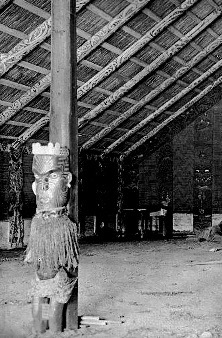
This is the post in the centre of a wharepuni
meeting-house that keeps its ridgepole from buckling. But
all Polynesian languages, including Te Reo Māori, are
poetic, with layers of meaning: the wharepuni building
represents the iwi's founder, and Pou-toko-manawa means "the
pole supporting the heart of
our founder."
Nearly all of us have someone who has given us support and
space to move when the weight of the world was pressing
down on us; mother, teacher, big sister, workmate.... (who
was yours?) and Mt Ruapehu is a pole supporting us by
giving us unique status and sheltering us from cyclonic
winds. It provides us with fertile volcanic ash for our
vegetable industry, with sharp winter weather to keep
those veges chilled until wanted, a plentiful supply of
fresh water, a tourist industry --- and millennial
protection from Taupo's nuclear-force eruptions!
4. Te
Waiū-o-te-Ika
"The Milk of Maui's
Fish" is the Whangaehu/Mangawhero water catchment.
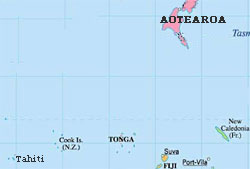 Children
are told that 'Maui used his grandfather's jawbone to
pull up a giant fish.'
Children
are told that 'Maui used his grandfather's jawbone to
pull up a giant fish.'
This summarizes how Kupe was motivated with an
adventurous 'Maui' spirit that implanted in him from years
of having his adventurous grandfather Maru-tawiti
jawboning on about how he could get through those cold
rough seas far to the south to get up in the high
latitudes where 100,000 whales and untold millions of
seabirds migrated to every year: "There must be
some huuuge motu up there, eh boy? But you'll
need really strong high bowposts and sternposts to be
your four taniwha to part the huge killer waves, you
must take wind-and-waterproof korowai to fight the ice
demons, and you must remember to leave Rarotonga in
December when the prevailing sou-westerly headwinds
change to nor-easterly tailwinds; OK boy?"
 Eventually,
as those nor-easterlies made world rotate under his
vessel, Kupe and his crew spotted great long clouds of
white fish-catching birds, millions of them. Then the
mother of all whales, Te-Ika-o-Maui, came up over the
horizon spouting volcanic 'water vapour' as she appeared.
Whales give milk, and both the Whangaehu and Mangawhero
rivers have milky-coloured headwaters (volcanic ash and
precipitated silica respectively).
Eventually,
as those nor-easterlies made world rotate under his
vessel, Kupe and his crew spotted great long clouds of
white fish-catching birds, millions of them. Then the
mother of all whales, Te-Ika-o-Maui, came up over the
horizon spouting volcanic 'water vapour' as she appeared.
Whales give milk, and both the Whangaehu and Mangawhero
rivers have milky-coloured headwaters (volcanic ash and
precipitated silica respectively).
In 2018, the Government of New Zealand and the Ngāti Rangi
iwi signed a deed of settlement providing for, among other
things, a redress framework for the Whangaehu River, known
as the Te Waiū-o-te-Ika Framework, with Te
Waiū-o-te-Ika meaning the living and indivisible
whole of the Whangaehu River and its tributaries, its
physical elements (including minerals) and metaphysical
elements, from Te Wai ā-Moe crater lake to the sea.
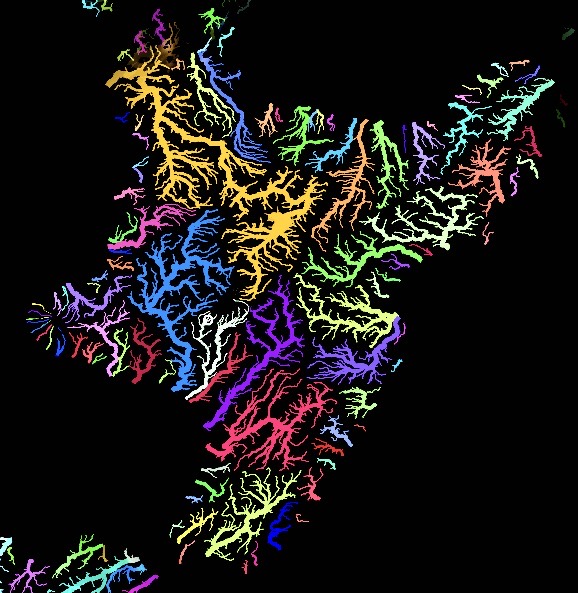
Te Waiū-o-te-Ika
O =
Ohakune. How many other rivers and streams can you
name?
5. Te Wai Ā-moe
There was very little activity in Ruapehu’s crater lake
in the late 1950s and early 1960s. The volcano seemed to
be sleeping, and consequently the lake became a tourist
attraction. The lake was filled by melting snow and summer
rain, and these waters were heated by steam rising from
the lake bed.
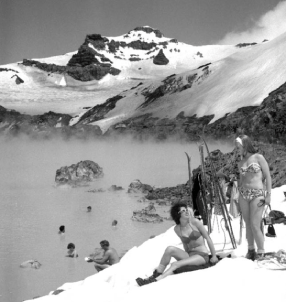
Renewed volcanic activity after 1965 made the lake more
acidic and more unpredictable, resulting in small
steam-blast
eruptions in 1980, sending a high-density mix of very
hot lava blocks, pumice, ash and volcanic gas across the
lake's surface.

Then in 1995-96 it erupted massively and repeatedly.  <
<
6. Wai-ariki
Ariki were chiefs, leaders, those of high rank, and in
districts where the were no geothermal pools, wai-ariki
were baths prepared to ease the aches and pains of elderly
ariki by heating rocks in a fire, then dropping the rocks
into a small pool to heat the water. Titoki berries may
have been added to scent the water, and kumarahou leaves
to make it soapy.
(Can anyone give me more
information about these therapeutic baths?)
But the hot water in Ruapehu's crater lake, and in the
more accessible Ketetahi hot springs 800m lower down the
mountain, provided chiefly hot baths for everyone in the
iwi !

As well as some pleasantly warm waiariki in Ketetahi
Springs, there are dozens of mudpools, boiling springs,
and exploding steam fumaroles over an area of about 30
hectares, with an energy output of about 100 megawatts, so
beware!
Ngatoro-i-Rangi
The tohunga/navigator of the Arawa voyaging walked south
to the central North Island six centuries ago, re-naming
land and then claiming it as he went, and in the course of
his travels he ascended the mountains' central lofty cone
in order to survey the surrounding country. He was
caught at its summit in a snowstorm, and he used these
words in his prayer to his goddess 'sisters' who now
resided on the very explosive Whaka-ari that we call White
Island.
"E Kuiwai e! E Haungaroa e! Kua riro au i te tonga;
Haria mai he ahi moku!"
"0 Kuiwai, 0 Haungaroa! I
am being borne away by the south
wind.
Send some fires for me!"
From the words "riro" (borne away, seized) and "tonga"
(south, wind) used in the land-hunter's cry came the name
Tonga-riro.
As for the name Ngauruhoe, he had a slave girl
named Uruhoe with him as a guide and porter, one of the Te
Tini o Toi people who had arrived in an earlier migration,
and he slew her on the mountain top as an offering to his
goddess sisters, in order to give additional force to his
prayer for fire. When fire did come from the crater, he
threw her body into the inferno as thanks.
It would appear that his goddess sisters threw three
'baskets' of fire to him, with one basket falling short at
the aptly named Kete-tahi, one going too far, to Ruapehu,
and the last one hitting the sweet spot.
My question is where did the plural 'Nga' come from in
front of Uruhoe?
I think the original lass had a rather explosive
temperament, and a fiery spirit that would have become
more and more fiery and explosive when they were trapped
on the summit.
"I told you, I told you there was a storm
coming; I told you!"
I korero ahau ki a koe kei te haere mai he tupuhi ; I
korero ahau!
My guess is he killed her in the hope that all this fiery
spirit would pass on to the mountain. And also to stop her
yelling at him.
So was the volcano's original name Nga-ahi-o-Uruhoe: The
fires of Uruhoe?
7.
Whangaehu
Whanga-ehu = an estuary that is murky. A children's fable,
He Potiki Mo
Wharaurangi, tells them that this river, and others
up and down the same coast, were given their descriptive
names by Hau, an ariki who came on the
Aotea
voyaging waka and whose wife had run off with one of
the
Multitudes of Tio, descendants of the island's first
settlers.
Children were helped to remember the Whangaehu river's
name and location by being told that its muddy bottom
was stirred up,
tiehutia,
as Hau ran through it in pursuit of his
wife's seducer.
Of course the river, and all the other rivers listed in
this fable, would have been given their names a century
earlier by the
Multitudes of Tio. This fable served as a geography
lesson, as a warning to young wives not to go running
off with handsome strangers, and as claim to ownership
by Hau's descendants, and not by Te Tini o Tio, who
were now slaves. Name-giving implies ownership.
8.
He Pou e Poua ki Runga
"A boundary marker raised up high."
The third verse is a variation of an old karakia that is
still widely used to this day.
Poua
ki runga,
Poua ki raro
Poua ki tāmoremore nui nō Rangi
ki
tāmoremore nui nō Papa
He rongo, he āio,
Tēnā tawhito pou ka tū
E tū nei te pou!
|
Established
to great heights
Established
to great depths
Established
as a huge clear expanse
as a huge clear physical expanse
peaceful, calm
This ancient landmark is standing
and
the landmark will keep standing here.|
|
Matua Che has changed this to....
He pou, te pou i poua
ki runga
ki Rangi-tāmore-nui
He pou te pou i poua ki raro
ki Papa-tāmore-nui
Poua ki te whenua, poua ki te rangi e
|
A boundary marker, the landmark
raised up
as a big
pinnacle
leading to the spirit worlū.
the
boundary marker placed in the
island's
centre
as a
big pinnacle on
the land
Planted on the ground, leading
towards
the spirit world
|
Ruapehu's peak is the highest of many tribal boundary
markers on the volcanic plateau. I have described these
overlapping
boundary
markers in detail in my
History
of Waiouru.
It is also a boundary marker linking the spiritual and
physical worlds.
9. Hei wai
ora e, poua ki Ruapehu
The living waters are stored up on the mountain as ice in
glaciers, or huka-papa, "snow-that's-solid." In winter,
fallen snow becomes compacted as ice at the top of a
glacier, and in times of summer drought, the ice at the
warmer bottom end melts and supplies water for drinking
and irrigating crops.
Mangaehuehu glacier once extended down to about 1500m
altitude, and was used to keep the birds that were
harvested in autumn 'deep frozen' to supply food for
winter.
But by the 1940s it had retreated to about 2000m and then
to 2100m by the 1970s. By 2010 it was above the rock wall
at 2250m, and was growing thinner.
Ruapehu is now hanging out a message of warning that we
have burnt too many trees, driven too many vehicles too
far, flown on too many tourist flights, generated too much
coal-fired power, farmed too many cattle beasts and dairy
cows, made too much cement, and consequently we are now
losing our supplies of life-saving stored water.
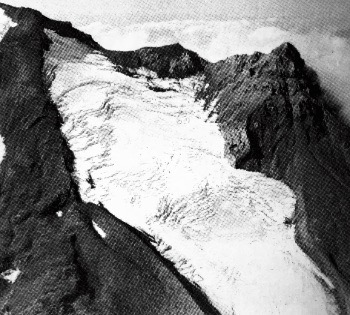
1940s
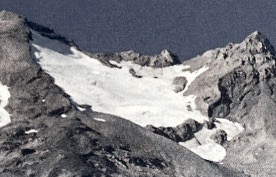
1972

2010
A Spiritual Connection

I've
had a typical Pakeha upbringing, and as Westerners, we
Pakeha were educated to think only with the conscious
fraction of our minds, or with our "left-brains," so
generally we only think in a logical, factual,
individualistic way.
To enable the soulless leaders of the British Empire to
grow rich by killing other peoples and then
asset-stripping their lands, we Pakeha have been
programmed to ignore our intuitive connections associated
with places, objects and past generations, symbolic
associations that are generated by our collective
unconscious, in our "right-brains."
But the connections are there. This is why those who have
a holistic
left-and-right brain upbringing are able to experience Ruapehu,
Te Wai Āmoe,Te Waiū-o-te-ik
a,
Rangi-tāmore-nui etc as living beings
that care for local humans and who the local humans (a
group united as one by their relationship with the great
mountain) must in turn take care of.
Endnotes
1.
In 2005, my niece, Ruth Basher, spent a year in the
Ketetahi hut working on
her
Master's thesis, which was
downgraded to 2nd-class honours because she 'wrongly'
predicted that further eruptions were likely from the Te
Maari crater, not far from the Ketetahi Springs. In
2012, hikers doing the Tongariro Crossing ran for their
lives when Te Maari did indeed erupt suddenly, as caught
in this video
sequence. Perhaps Ruth was more tuned in to her
unconscious mind than most MSc students.
 2.
I spent my childhood in Mangamahu, and when I was 12,
Ruapehu sent extra wai-u down Te Awa o Whangaehu on
Christmas morning;
wai-u that brought us many 'presents.'
2.
I spent my childhood in Mangamahu, and when I was 12,
Ruapehu sent extra wai-u down Te Awa o Whangaehu on
Christmas morning;
wai-u that brought us many 'presents.'
Presents,
alas, which had to be stored in the shed
beside our house every day for several weeks, making the
river wai-kūkua for many in our village. Pillows
of the Dead.
 for storing food, a utilitarian pantry that rats, mice and
cockroaches can't get into. Here is a pākata in Ohinemuta
in the 1850s.
for storing food, a utilitarian pantry that rats, mice and
cockroaches can't get into. Here is a pākata in Ohinemuta
in the 1850s.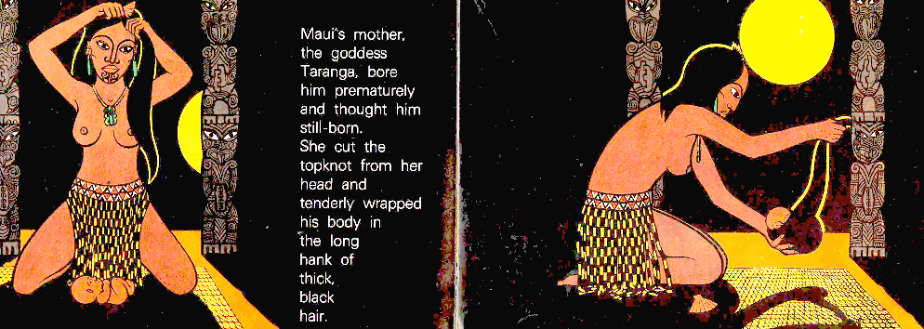
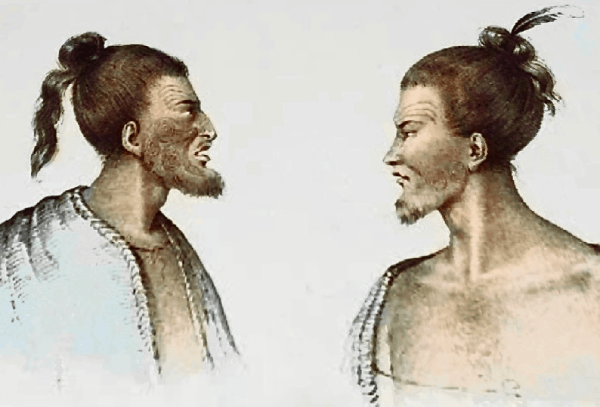


 Children
are told that 'Maui used his grandfather's jawbone to
pull up a giant fish.'
Children
are told that 'Maui used his grandfather's jawbone to
pull up a giant fish.'  Eventually,
as those nor-easterlies made world rotate under his
vessel, Kupe and his crew spotted great long clouds of
white fish-catching birds, millions of them. Then the
mother of all whales, Te-Ika-o-Maui, came up over the
horizon spouting volcanic 'water vapour' as she appeared.
Whales give milk, and both the Whangaehu and Mangawhero
rivers have milky-coloured headwaters (volcanic ash and
precipitated silica respectively).
Eventually,
as those nor-easterlies made world rotate under his
vessel, Kupe and his crew spotted great long clouds of
white fish-catching birds, millions of them. Then the
mother of all whales, Te-Ika-o-Maui, came up over the
horizon spouting volcanic 'water vapour' as she appeared.
Whales give milk, and both the Whangaehu and Mangawhero
rivers have milky-coloured headwaters (volcanic ash and
precipitated silica respectively).


 <
< 





 I've
had a typical Pakeha upbringing, and as Westerners, we
Pakeha were educated to think only with the conscious
fraction of our minds, or with our "left-brains," so
generally we only think in a logical, factual,
individualistic way.
I've
had a typical Pakeha upbringing, and as Westerners, we
Pakeha were educated to think only with the conscious
fraction of our minds, or with our "left-brains," so
generally we only think in a logical, factual,
individualistic way. 2.
I spent my childhood in Mangamahu, and when I was 12,
Ruapehu sent extra wai-u down Te Awa o Whangaehu on
Christmas morning
2.
I spent my childhood in Mangamahu, and when I was 12,
Ruapehu sent extra wai-u down Te Awa o Whangaehu on
Christmas morning